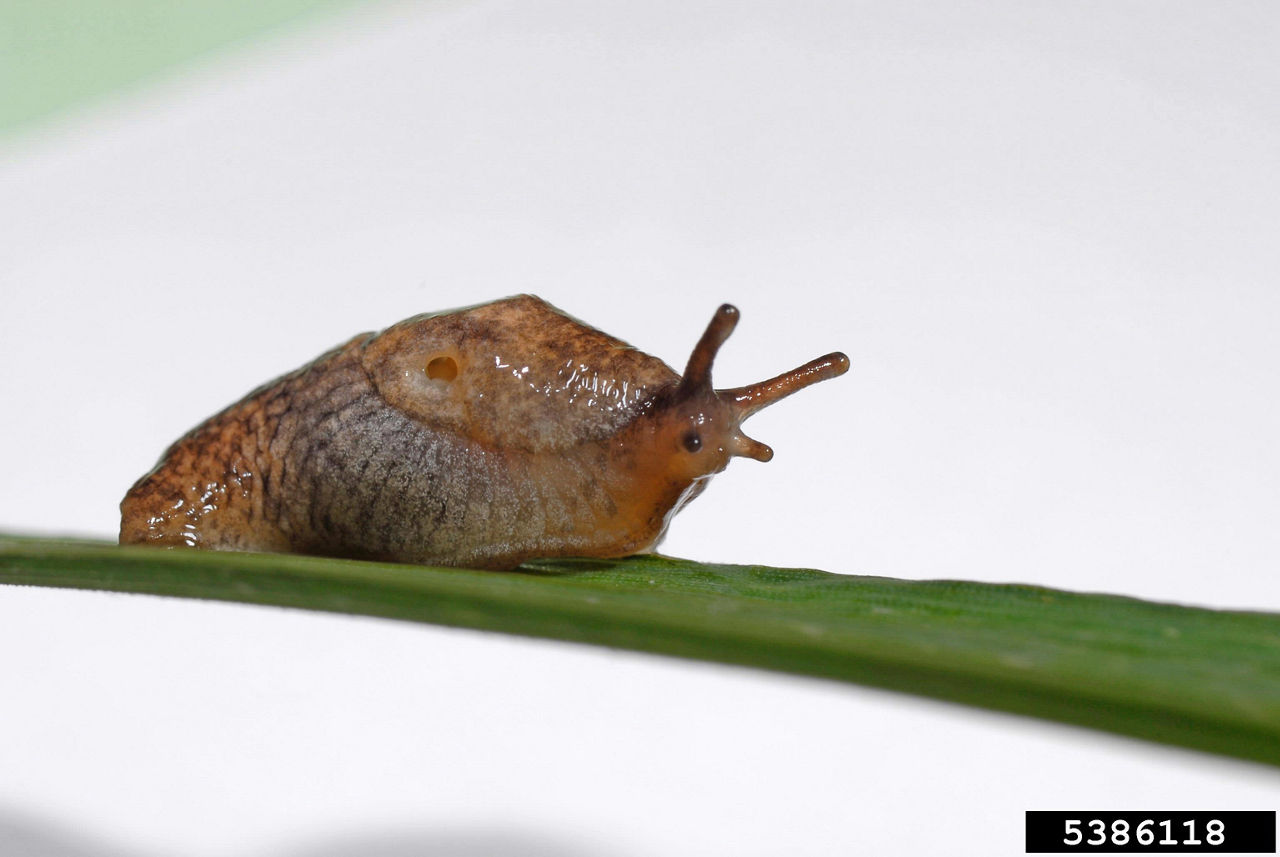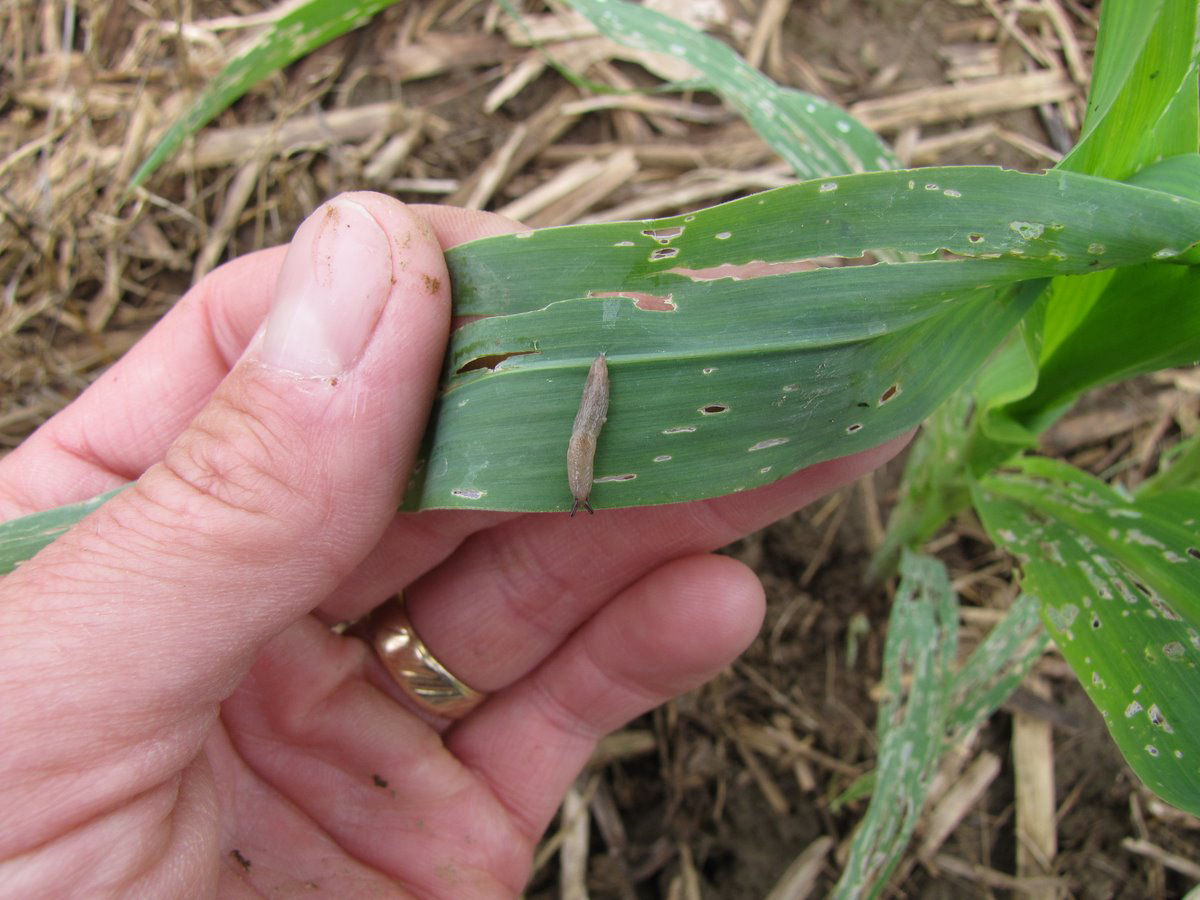3 MIN READ
Slug Damage in Corn
April 16, 2025
What are slugs?
Slugs are slimy mollusks closely related to snails but without a shell. Their bodies are soft, legless, and have four front tentacles – of which two have eyes and two are essentially antennae (Figure 1). They secrete mucus that aides in movement and defense, and that also serves as an identifiable clue to their presence.1

Of the many slug species, which ones are potentially the most economically injurious to crops?
The gray garden (Deroceras reticulatum), marsh (Deroceras laeve), dusky (Arion subfuscus), and the orange-banded (Arion fasciatus) slugs are the most commonly found species in crop production. Of these, the dominant and most economically important in agricultural crops is the gray garden slug. The gray garden slug is light to dark gray, about two inches long as an adult, and has a mottled appearance.1
Economic thresholds have not been determined for slug management because many crops, including corn, can withstand considerable seedling injury without the loss of potential yield.1 Economic Injury Levels (EILs, EIL) from one research program established the EIL range for slug injury to corn seedlings to be two to 20% of removed leaf area in a warm, wet year and 39 to 59% removal in dry years.2
What is the lifecycle of a slug?
A slug has three growth stages – egg, juvenile, and adult. The eggs are small, gelatinous, oval-shaped, and are usually found on crop residue or in the soil. Depending on the region, slugs may overwinter as eggs or adults, though extremely cold winters are likely to eliminate all overwintering stages unless there is a good snowpack.3 The overwintering adults lay eggs in early spring after temperatures support their activity. Slug activity could begin in early April in southern areas and will likely occur later in northern areas. Juvenile slugs resemble small adults as soon as they hatch from overwintering or newly laid eggs. The juveniles generally start feeding on nearby plants within one to two weeks after hatching, reach maturity in late summer or early fall, mate, and – depending on location – may lay eggs. The lifespan of the gray garden slug is about twelve months.1
The lifecycle of the slug species may vary in regards to egg laying time and the overwintering stage. Various stages of the gray garden slug can be found throughout the growing season as the stages of development are not well synchronized across a population.
Which fields are more likely to have slug populations?
Slugs prefer a moist, cool, and undisturbed environment which can be provided with the residue of conservation tillage systems. Reports from the mid-Atlantic states indicate that about 20% of no-till fields suffer economic losses and 47% of growers indicate that considerable slug damage occurs every two to three years.1
How do slugs injure plants?
Along with corn, slugs feed on a wide range of plants including cereals, soybean, canola, alfalfa, and cover crops. Usually, the most injury to field crops – including corn – occurs soon after planting, when the juvenile gray garden slugs are searching for food. Injury may occur and be more severe in the early season if the winter was mild enough to allow a relatively high number of adult slugs to survive, as adults can begin feeding as soon as environmental conditions become favorable. However, after a severe winter that eliminated more adult slugs, injury may occur later in the season because of the time needed for eggs to hatch and juveniles to begin feeding. Injury can appear as scarifying on the surface of plant tissues and holes in leaf tissues (Figure 2). Unlike soybean, the growing point of a corn seedling remains underground until four to six weeks (about five to seven collared leaves) after emergence, which usually protects the growing point from slug damage as slugs cannot burrow into the ground. However, if the seeding furrow is not fully closed, slugs could travel down the seed furrow and potentially feed on the growing point. If the growing point is damaged, the seedling is likely to die, become deformed, or sprout several tillers without developing a primary stalk and ear. Seeds in an open seed furrow could also be fed upon by slugs.

When should scouting occur
Prior to planting, look under and on field residue for eggs and adults. After planting, seedlings should be scouted for juvenile slug feeding. The soil may show signs of the slimy trails slugs leave behind as they move around. If feeding is occurring on the seedlings, observe leaves for holes and scarification. Observation for slugs after planting is best completed at dusk or later with a flashlight, as slugs avoid sunshine and heat. However, on cloudy, cool, wet days, they may be found feeding during daylight. Another way to check for slug presence is by placing a piece of cardboard, shingle, wood, or other object on the soil surface to create a cool, wet environment. After a few days, pick up the object and observe the soil surface for the adults and juveniles.
Are there any management techniques?
In-season options to control slugs are limited. Molluscicide baits containing a concentration of 3.25% to 4% metaldehyde may be available for management; however, they are water soluble which can limit their longevity. Baits containing iron phosphate are another potential option.4,5,6
Tillage can disrupt and expose slugs to the elements and is a good way to reduce infestations. However, tillage is an unlikely solution for dedicated conservation tillage producers. Row cleaners on the planter may help move slug-protective residue away from the crop row and help warm the soil for quicker corn seedling emergence. Seedlings that grow quickly can become too large for slug feeding to cause appreciable injury.
Seed furrow closure is very important as seed furrows that are open allow slugs to move freely from one plant to the next. Planter furrow closers should be adjusted to help assure soil is moved on to the seed furrow. Proper closure can also help keep seeds protected from birds and other wildlife.
Planting before slugs appear may help corn seedlings become established and become too large for economic injury from slugs. Alternatively, planting later after soils have warmed and become drier may reduce the potential for feeding as dry soil is not conducive for slug development. Warm weather, sunshine, and dry soils are likely the best way to reduce the potential for slug feeding and potential yield loss.
If the corn plant population is greatly reduced, replanting may be an option. However, replanting should be evaluated based on a measured population, extra inputs (seed, chemistry), labor, weather forecast, and other factors. For additional corn replanting information, please see Corn Replanting Decisions.
Sources
1Douglas, M.R. and Tooker, J.F. 2012. Slug (Mollusca: Agriolimacidae, Arionidae) ecology and management in no-till field crops, with an emphasis on the mid-Atlantic region. Journal of Integrated Pest Management. 3(1): C1–C9. https://doi.org/10.1603/IPM11023
2Byers, R.A. and Calvin, D.D. 1994. Economic injury levels to field corn from slug (Stylommatophora: Agrolimacidae) feeding. Journal of Economic Entomology. 87(5): 1345–1350.
3Douglas, M.R. and Tooker, J.F. 2010 (updated 2023). Slugs as pests of field crops. PennState Extension. https://extension.psu.edu/slugs-as-pests-of-field-crops
4Igwe, P.-G., Cramer, M., Owens, D., Dively, G., and Hamby, K. 2023. Managing slugs in field crops using IPM principles. University of Maryland Extension, Agriculture & Food Systems. FS-2022-0629. https://extension.umd.edu/extension.umd.edu/sites/extension.umd.edu/files/publications/ManagingSlugsInFieldCrops_FS-2022-0629_ada.pdf
5Cochran, R. and Tilmon, K. 2023 revision. (original 2014 authors: Hammond, R.B., Michel, A., and Eisley, J.B.) Slugs on field crops. Ohio State University Extension, Ohioline. ENT-20. https://ohioline.osu.edu/factsheet/ENT-20
6DiFonzo, C. and Tilmon, K. MSU-OSU field crops insect pest management guide. Michigan State University and The Ohio State University. https://aginsects.osu.edu/sites/aginsects/files/imce/MSU%20-%20OSU%20Insect%20IPM%20Guide.pdf
Web sources verified 04/08/25. 1215_121756